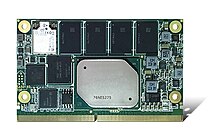SMARC
SMARC ( S mart M obility ARC hitecture) is a specification of the Standardization Group for Embedded Technologies eV (SGET) for Computer-on-Module (COM). SMARC Computer-on-Modules are specially designed for the development of extremely compact low-power systems. SMARC modules are usually based on ARM processors , but can also be equipped with other low-power SoC architectures, such as those based on x86 SoCs. The power requirement of the modules is typically well below 5 watts, which opens up markets that previously could not be reached by more consumption-intensive processor designs.
Computer-on-modules integrate the core functionality of a bootable computer , such as SoC, as well as additional circuits, including DRAM , boot flash, voltage distribution, Ethernet and display transmitters. The modules are used together with an application-specific carrier board, the size and shape of which can be defined customer-specifically. The carrier board carries the required interfaces and, if necessary, integrates further functionalities, such as audio codecs, touch controllers, wireless communication interfaces, etc.
The SMARC specification defines the dimensions of the module, the placement of the mounting holes, as well as the connector to the carrier board and the interfaces to be implemented including pin assignment; the pin assignment is optimized for the interface options of ARM and low-power SoCs and differs from classic PC interfaces due to its targeted focus on low-power and mobile applications.
SMARC is based on the ULP-COM form factor presented in 2011 by Kontron and Adlink. In the course of the specification by SGET, the standard was renamed SMARC.
Dimensions
SMARC defines two module sizes:
- 82 mm × 50 mm, for extremely compact low-power designs
- 82 mm × 80 mm, for more powerful SoCs with increased space and cooling requirements
Connector
SMARC Computer-on-Modules have 314 card-edge contacts on the printed circuit board of the module (PCB), which is received by a low-profile connector on the carrier board. The connector usually has a height of 4.3 mm. It is also used for MXM 3.0 graphics cards , naturally with completely different pin assignments.
Signal lines and pin assignment
The signals are transmitted via a total of 314 pins. With 33 reserved signal lines for power supply and ground, SMARC effectively has 281 signal lines available. The defined interfaces include ARM and SoC-typical, energy-saving interfaces, such as parallel LCD for display connection, Mobile Industry Processor Interfaces for cameras, Serial Peripheral Interface (SPI) for general peripheral connection, I²S for audio and I2C . In addition, classic computer interfaces such as USB , SATA and PCI Express are also defined.
In the current version of the SMARC specification, not all of the 314 signal lines are assigned fixed I / Os. The Alternate Function Block (AFB) has free pins available for different requirements. Its purpose is to ensure that the SMARC specification can also flexibly incorporate future technical developments that are not yet foreseeable and still retain full compatibility with previous designs. On the one hand, extended versions of the SMARC specification can assign new standard functions to these 20 signal lines of the AFB. On the other hand, the SMARC specification 1.1 currently lists the MOST bus , dual gigabit Ethernet , USB 3.0 or industrial network protocols as currently conceivable and assignable interfaces of the AFB.
specification
The SMARC hardware specification is maintained by SGET. It is freely available for download on the SGET website. The current version is 2.0
Web links
- SGET website
- SMARC specification as a free download ("SMARC Hardware Specification V2.0") (ZIP; 1.4 MB)
Individual evidence
- ↑ SGET adopts SMARC . elektroniknet.de. Retrieved April 4, 2013.

